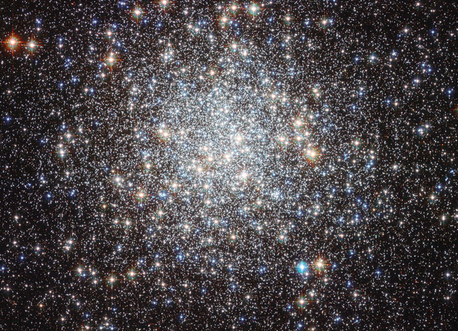Hubble
Hubble Sees Glittering Jewels of Messier 9
 |
The globular cluster "Messier 9" (c) NASA
The contrast between Messier’s equipment and the tools at the disposal of today’s astronomers is stark. Hubble’s image, the highest resolution image yet made of Messier 9, is able to resolve individual stars, right into the crowded centre of the cluster. Over 250,000 of them are neatly focused on the detector of Hubble’s Advanced Camera for Surveys, in an image which covers an area no bigger than the size of the head of a pin held at arm’s length. As well as showing the individual stars, Hubble’s image clearly shows the different colors of the stars. A star’s color is directly related to its temperature — counter-intuitively, perhaps, the redder it is, the cooler it is; and the bluer it is, the hotter. The wide range of stellar temperatures here is clearly displayed by the broad palette of colors visible in Hubble’s image of Messier 9. Messier 9’s neighborhood is interesting too, and is marked by two vast and dark nebulae. These pitch-black clouds of interstellar dust are known as Barnard 259 (to the south-east of Messier 9) and Barnard 64 (to the west), and are clearly visible in wide-field images of the cluster. The Hubble Space Telescope is a project of international cooperation between ESA and NASA.
Credit: NASA
Hubble
Hubble Sees Glittering Jewels of Messier 9
 |
The globular cluster "Messier 9" (c) NASA
The contrast between Messier’s equipment and the tools at the disposal of today’s astronomers is stark. Hubble’s image, the highest resolution image yet made of Messier 9, is able to resolve individual stars, right into the crowded centre of the cluster. Over 250,000 of them are neatly focused on the detector of Hubble’s Advanced Camera for Surveys, in an image which covers an area no bigger than the size of the head of a pin held at arm’s length. As well as showing the individual stars, Hubble’s image clearly shows the different colors of the stars. A star’s color is directly related to its temperature — counter-intuitively, perhaps, the redder it is, the cooler it is; and the bluer it is, the hotter. The wide range of stellar temperatures here is clearly displayed by the broad palette of colors visible in Hubble’s image of Messier 9. Messier 9’s neighborhood is interesting too, and is marked by two vast and dark nebulae. These pitch-black clouds of interstellar dust are known as Barnard 259 (to the south-east of Messier 9) and Barnard 64 (to the west), and are clearly visible in wide-field images of the cluster. The Hubble Space Telescope is a project of international cooperation between ESA and NASA.
Credit: NASA






